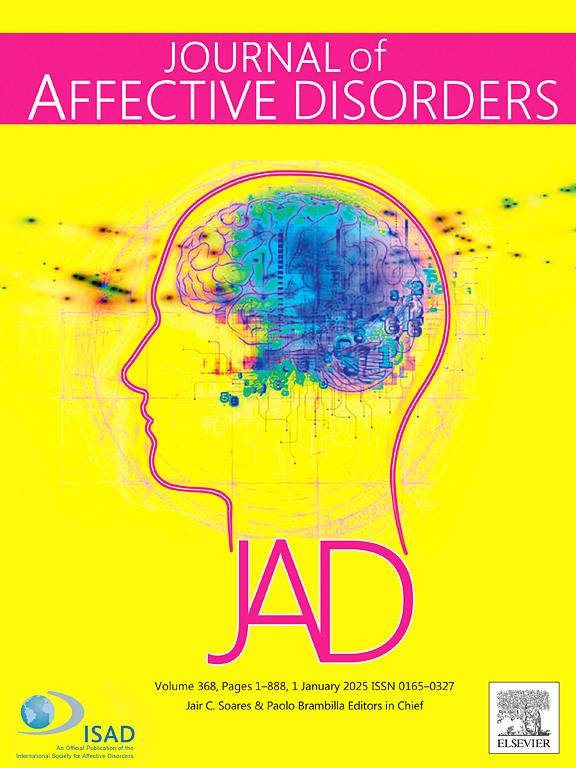Suicidal thoughts and behaviors in adolescents with mood disorders: Insights from a nationally representative sample
IF 4.9
2区 医学
Q1 CLINICAL NEUROLOGY
引用次数: 0
Abstract
Background
Suicide is a leading cause of death in adolescents, and major mood disorders confer a greatly increased risk. Few population-based studies have investigated the distinct and overlapping clinical correlates of suicidality in adolescents with bipolar disorder (BD) and major depressive disorder (MDD). Understanding these correlates may inform targeted prevention and intervention strategies. This study aims to examine the clinical correlates of suicidal thoughts and behaviors (STBs) in a nationally representative sample of adolescents with and without mood disorders.
Methods
Data from the National Comorbidity Survey – Adolescent Supplement (NCS-A; 2001–2004) was examined to compare the prevalence and clinical correlates of suicidal ideation/plan and suicide attempts between adolescents with BD, MDD, and those without mood disorders. Participants, ages 13–18 years, were interviewed using a modified version of the Composite International Diagnostic Interview to confirm diagnoses for BD (n = 295), MDD (n = 1112) or controls without mood disorders (n = 8716).
Results
Lifetime prevalence of suicide attempts in adolescents with BD (14.9 %) and MDD (17.2 %) was higher than in controls (1.4 %). Similarly, suicidal plans/ideation were more prevalent among adolescents with BD (20.4 %) and MDD (22.8 %) than controls (6.5 %). STBs were associated with longer duration of depressive episodes, antidepressant use, mental health treatment, and experiences of physical/sexual abuse in both MDD and BD groups.
Conclusions
STBs are associated with multiple shared clinical correlates alongside diagnosis-specific correlates. These findings highlight the significance of depression burden and reward-related behaviors (smoking, SUD, eating disorders) as risk indicators, which could guide the development of targeted prevention and treatment strategies.
情绪障碍青少年的自杀想法和行为:来自全国代表性样本的见解。
背景:自杀是青少年死亡的主要原因,而严重的情绪障碍会大大增加自杀的风险。很少有基于人群的研究调查了双相情感障碍(BD)和重度抑郁症(MDD)青少年自杀的独特和重叠的临床相关性。了解这些相关性可以为有针对性的预防和干预策略提供信息。本研究的目的是检查自杀念头和行为(STBs)的临床相关性在一个具有全国代表性的样本的青少年有和没有情绪障碍。方法:数据来自国家合并症调查-青少年补充(NCS-A;(2001-2004),比较了患有双相障碍、重度抑郁症和无情绪障碍青少年之间自杀意念/计划和自杀企图的患病率和临床相关性。参与者年龄为13-18岁 ,使用改良版的复合国际诊断访谈进行访谈,以确认双相障碍(n = 295)、重度抑郁症(n = 1112)或无情绪障碍对照(n = 8716)的诊断。结果:青少年双相障碍(14.9 %)和重度抑郁症(17.2 %)的终生自杀企图率高于对照组(1.4 %)。同样,自杀计划/意念在患有双相障碍(20.4% %)和重度抑郁症(22.8% %)的青少年中比对照组(6.5% %)更为普遍。在MDD和BD组中,性传播感染与更长的抑郁发作持续时间、抗抑郁药的使用、心理健康治疗以及身体/性虐待的经历有关。结论:自杀意念和企图与多种共同的临床相关因素以及诊断特异性相关因素相关。这些发现强调了抑郁负担和奖励相关行为(吸烟、SUD、饮食失调)作为风险指标的重要性,可以指导制定有针对性的预防和治疗策略。
本文章由计算机程序翻译,如有差异,请以英文原文为准。
求助全文
约1分钟内获得全文
求助全文
来源期刊

Journal of affective disorders
医学-精神病学
CiteScore
10.90
自引率
6.10%
发文量
1319
审稿时长
9.3 weeks
期刊介绍:
The Journal of Affective Disorders publishes papers concerned with affective disorders in the widest sense: depression, mania, mood spectrum, emotions and personality, anxiety and stress. It is interdisciplinary and aims to bring together different approaches for a diverse readership. Top quality papers will be accepted dealing with any aspect of affective disorders, including neuroimaging, cognitive neurosciences, genetics, molecular biology, experimental and clinical neurosciences, pharmacology, neuroimmunoendocrinology, intervention and treatment trials.
 求助内容:
求助内容: 应助结果提醒方式:
应助结果提醒方式:


